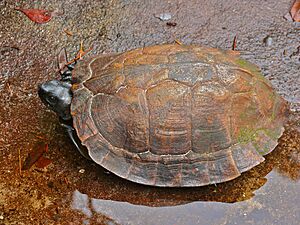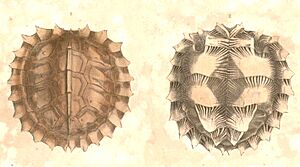Spiny turtle facts for kids
Quick facts for kids Spiny turtle |
|
|---|---|
 |
|
| Conservation status | |
| Scientific classification | |
| Genus: |
Heosemys
|
| Species: |
spinosa
|
| Synonyms | |
|
|
The spiny turtle (Heosemys spinosa) is a unique turtle found in South-East Asia. These turtles live in rainforests, both in lowlands and on hills. You can often find them near small streams in hilly areas, sometimes as high as 1,000 meters (about 3,300 feet) above sea level. They live in several countries, including Brunei, Indonesia, Malaysia, Myanmar, the Philippines, Singapore, and Thailand.
Contents
What Does the Spiny Turtle Look Like?
The spiny turtle is a medium-sized turtle. It has a brown shell and a head with red spots. People sometimes call it the "cog-wheel turtle." This is because its shell, called a carapace, has spiky edges. It also has spiny parts called scutes and a spiky keel down its back.
When spiny turtles are young, their shell's underside is yellow with black stripes. As they grow into adults, these colors fade. The jagged edges on their shell also become smaller. In adult turtles, these spikes are mostly found at the back of the shell. These changes help protect young turtles from predators.
Where Does the Spiny Turtle Live?
The spiny turtle is found in Brunei, Indonesia, Malaysia, Myanmar, the Philippines, Singapore, and Thailand. They prefer to live along small rivers and streams in forested areas. You can usually find them in mountains at altitudes from 170 meters (about 560 feet) to 1,000 meters (about 3,300 feet) above sea level.
How Big Are Spiny Turtles?
Adult spiny turtles usually have a shell length between 17.5 centimeters (about 7 inches) and 22 centimeters (about 8.7 inches). They typically weigh between 1.5 kilograms (about 3.3 pounds) and 2.0 kilograms (about 4.4 pounds).
Spiny Turtle Behavior and Diet
During the day, the spiny turtle often hides by burying itself in fallen leaves. This helps it blend in with its surroundings, a type of camouflage. It usually comes out at night to search for food.
While many think spiny turtles only eat plants, they also eat other things. They enjoy fruits and plants, but they also eat dead animals (carrion) and insects. A special fruit from the yin-ngan tree is very important to them. In Myanmar, these turtles often stay near these trees when the fruit is ripe. Young spiny turtles in zoos also like fruit salads, especially those with tomatoes.
Scientists have studied their droppings in Kubah National Park. They found that spiny turtles help spread seeds from five different types of plants. This shows they play a role in helping forests grow. They also found insect parts and hair, meaning the turtles eat small animals too.
Spiny Turtle Reproduction and Life Cycle
Spiny turtles usually mate in December and February. Rain seems to be a trigger for them to start mating. In the wild, a female turtle lays one or two eggs in a nest. She can lay up to three groups of eggs each year.
When turtles are in captivity (like in zoos), spraying male turtles with water can make them chase females and try to mate. Before laying an egg, a female turtle's lower shell, called a plastron, becomes flexible. This helps her lay the egg more easily. The egg is often partly covered with dirt or leaves. Researchers have found eggs hidden in safe spots, like under cork bark or thick plants.
It can be hard for spiny turtles to reproduce in captivity. Their eggshells are thick and can break if the ground is too wet. The first successful mating in a zoo happened in 1991 at Zoo Atlanta. The eggs took about 106 days to hatch. They were kept in a mix of peat moss and damp sand. For the first 35 days, the eggs were kept warm, between 28-30°C (82-86°F). For the rest of the time, the temperature was a bit cooler, between 26-28°C (79-82°F).
Protecting the Spiny Turtle
In 1996, the spiny turtle was listed as "vulnerable" by a group called the IUCN. By 2000, it became "endangered" because its numbers dropped a lot, especially in the Chinese food market. A big threat to these turtles is the destruction of their natural forest homes. Forests are often cut down to make way for palm oil farms, especially in southern Myanmar.
The spiny turtle is also caught for the international pet trade. It is also used in traditional Chinese medicine, which has further reduced its population. However, many efforts are being made to protect them. For example, the Philippines Wildlife Act protects these turtles. In 2013, a spiny turtle hatched at the Chester Zoo in the UK, which gave hope to people working to save the species.




